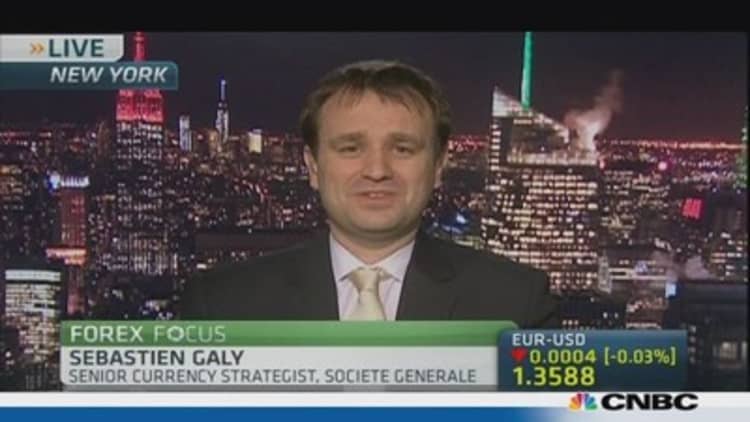The dollar slipped to its lowest level since the turn of the year against a basket of major currencies on Monday as soft U.S. economic data stood in contrast to better figures out of the euro zone and China.
The dollar index fell as low as 80.065, its lowest since January 1, and was last down marginally at 80.134. The euro touched a three-week high of $1.37245 and was last up 0.1 percent at $1.3700.
The greenback has been weighed down by recent soft economic data. On Friday, figures showed U.S. manufacturing output unexpectedly fell in January, prompting some commentators to question whether the Federal Reserve may slow the pace at which it cuts back its massive bond-buying stimulus.
Against the yen, the dollar fell to its lowest since February 6 but later recovered to trade up 0.1 percent at 101.89 yen after weaker-than-expected Japanese gross domestic product data.
"There's a general theme of dollar weakness," said Peter Kinsella, strategist with Commerzbank in London.
(Read more: Summers: US faces a 'Downton Abbey' economy)
"There's been a very patchy data outlook for the past six weeks to two months and expectations of a rate rise from the Fed have been curtailed."
He said the data had not been soft enough for the Fed to slow its tapering, but warned that a fall in stock markets could hit the dollar against the .

"Corrective bounce"
"The fly in the ointment is equity market sentiment. It looks like a corrective bounce rather than a sustained leg higher. The long equity trade is very consensual, which is a risk for , which has moved in lock-step (with that)."
Japan's economy grew less than expected in the fourth quarter of last year as consumer spending, business investment and exports disappointed, in a worrying sign of waning momentum before a planned sales tax increase.
Investors initially reacted by buying the yen - typically seen as a safe haven - against the dollar, but Kinsella said the numbers were distorted by imports and were "misleading".
(Read more: Japan's GDP miss - What went wrong?)
The prospect of Fed tapering and further loosening of Japanese monetary policy made betting on a consensus trade for hedge funds and other investors going into this year, but so far it has proved lossmaking.
Adam Cole, head of G10 FX strategy at RBC Capital, said the dollar could fall to 97 yen per dollar over the next two-to-three months.

"The risk in the near term is that it continues to defy consensus," he said.
But he added that ultimately the trade could be proved right. "Once we get nearer to the first Fed tightening there is scope for dollar-yen (to rise)."
The latest data showed currency speculators pared bets on the U.S. dollar in the weekended February 11.
Nevertheless, it was the 15th straight week in which speculators held net long positions in the greenback, reflecting a wider belief that the Fed will probably continue to wind back its extraordinary policy stimulus this year.
Volumes were thin in most currency pairs, with U.S. markets closed for Presidents Day and no major European data scheduled. Investors will keep an eye on a lecture by European Central Bank governing council member Ewald Nowotny later on Monday, after he earlier said there may be a case for waiting and seeing if it should change interest rates.
(Read more: Euro zone's surprise growth boosts recovery hopes)
The euro rose 0.2 percent against the to 139.67 yen, helped by data on Friday showing both Germany and France grew slightly faster than expected in the fourth quarter, pushing the euro zone's recovery up a gear.
Commodity currencies such as the Australian dollar were also in favor after Chinese lending data on Saturday suggested the world's second biggest economy may not be cooling as much as feared.
However, analysts warned that the data could be distorted by the Lunar New Year holidays in January. China is the biggest export market for Australia and New Zealand.
The Australian dollar hit a fresh one-month high of $0.9070, before ceding some ground to last stand at $0.9033.

